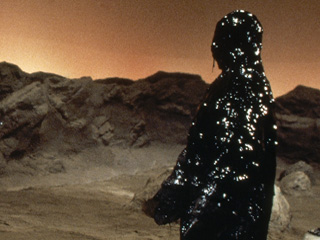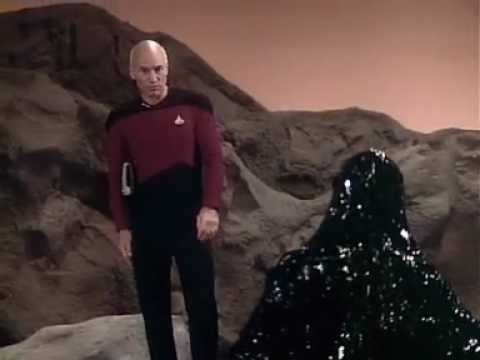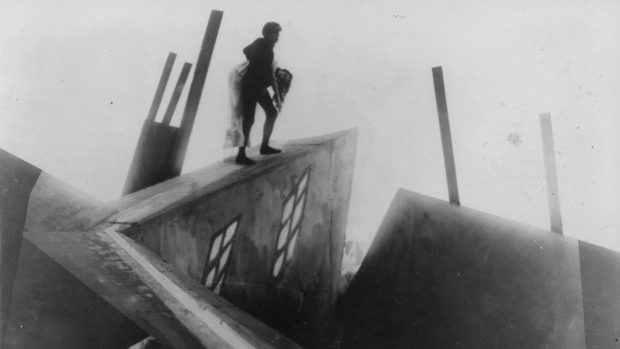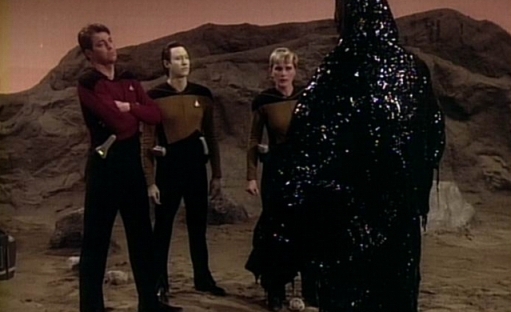I have a totally unconscious (I assure you) habit of liking most those examples of a canon which others like least. For instance, my favourite episode of the Matt Groening sci-fi sitcom Futurama was once “That’s Loberstainment!”, an episode (starring Dr. Zoidberg in an adventure where he makes a movie with his Charlie Chaplin-esque, “silent-hologram”-star uncle) so despised by fans that, in the DVD commentary, the makers discuss how the fans bashed it on online forums to a point of both ad nauseam and ad hominem.
It was therefore not too shocking to me that one of the episodes I enjoyed the most from Star Trek: The Next Generation‘s awkward, clunky first season (it’s certainly not my favourite episode overall; I’m not that much a misguided hipster geek) is “Skin of Evil”, most noted today as the episode where Lieutenant Tasha Yar was killed off, after actress Denise Crosby had become dissatisfied with her role on the programme. Critics have generally disparaged this episode.
And no, I don’t like it just because Lt. Yar was murdered in it. I honestly really liked that character (another symptom of the misguided hipster geek?). Unlike other examples of the “warrior woman” character in genre fiction, especially genre fiction of this time period, to me Yar felt like an actual, nuanced human being, not just an ultra-aggressive “bull dyke” caricature, beating to a pulp any man who asks her what the time is, because “strong woman” means egocentric psychopath.
She may not have been the best-written female character of all time (superficially, she still fitted the mould of the tomboy with the bowl-cut hair), but she was invested with a compassion and intelligence rarely seen in that more extreme instance of the “strong woman” archetype, where strength comes as much from a woman’s brawn as her soul.
She also provided a useful counterpoint to Counsellor Troi, the more lasting character whose strength did come from her soul, and what was at least implied to be a uniquely feminine understanding of emotions. In fact, this counterpoint is neatly revealed in Yar’s pre-recorded funeral message for her comrades at the end of the episode, where she tells Troi that she helped Yar realise her femininity could be just as much a part of her strength as anything.

But, on to the plot of the episode, which is what I most enjoyed about “Skin of Evil”. In some ways, this episode is very much a throwback to the visual and scriptural style of The Original Series. This may be due in part to the presence on the production team of Joseph Stefano, who devised the story, then co-wrote the script with Hannah Louise Shearer.
Stefano is best remembered today as the screenwriter for Alfred Hitchcock’s Psycho, adapting it from the pulp horror novel by Robert Bloch. It could be said that Stefano was well suited, then, to a 45-minute piece of television in the action and science-fiction genres.
The story begins with SS Enterprise trying to rendezvous with a shuttle containing Counsellor Troi, back from leave to resume her duties, when the shuttle gets caught in the gravitational pull of a nearby planet and dragged down to the surface. There, it is jealously guarded by what seems like a sentient oil slick, the titular skin of evil, named Armus, which can, as a liquid, change itself to the shape of any container, from a human body to the downed shuttle, and instantly leech the life force from organic beings.

This concept and the writing used to express it may go a long way towards explaining the negative critical response to “Skin of Evil”. Stefano, a 60s writer if ever there was one (he co-created the Twilight Zone-esque sci-fi show The Outer Limits), brings to his Next Generation effort a distinctly Original Series sensibility.
The dialogue is declarative and sensational (“I am a skin of evil left here by a race of Titans who believed if they rid themselves of me, they would free the bonds of destructiveness”), as opposed to symbolic and introspective, the tone of dialogue more generally associated with Next Generation episodes. To many critics, then, “Skin of Evil” might seem simply anachronistic and silly.
However, I’ve always been a fan of grand theatrics used in the representation of ideas. I enjoy the brutally efficient storytelling of classic genre fiction, where stories were self-contained and therefore more reliant on structure. Earlier Star Treks, at least, couldn’t afford to spend entire episodes hinting at rather than telling larger stories; in other words, they couldn’t afford to be soap operas. Not just every line but every word of dialogue needed to be about something immediately relevant. The grand, theatrical speeches of Armus may seem like cornball, moustache-twirling villainy now, but they relate information in a clear and engaging manner, acquainting the audience with the concept in as little time as possible.
Perhaps less advisably, like many episodes in TNG‘s first season, “Skin of Evil” uses the Original Series technique of rendering an alien sky as just a gradient block of colour, in this case a sort of dirty yellow, presumably chosen to emphasise the planet’s desolate, desert nature. This approach, reminiscent of German Expressionism (distorting reality to convey subjective experience and create emotional effects), was well-suited to the general aesthetic of original Star Trek, a 60s programme which utilised bright colours, and needed Expressionism in a time of more limited special effects.

Image from The Cabinet of Dr. Caligari (1920), a German Expressionist film:

Even in late 80s, first season Star Trek, however, it comes across as merely jarring and anachronistic. 20 years had passed since the dawn of the original series, and TNG had already established its own, distinct visual style, with toned-down colours and an at once more minimalist and more detailed approach (less wildly angular sets and eccentric costumes, more attention to gritty, detailed landscapes). Indeed, watching an episode of TOS after several of TNG, you might be struck in the face by the sheer artificial intensity of the colouring and sets.

As well as by how their “military uniforms” look like PJs
Also, TOS itself had progressed visually, in its movies; the first Star Trek film, though deeply flawed and today considered one of those weak odd-numered entries in the film canon (alongside Star Trek V: The Final Frontier and TNG‘s own Insurrection), was a milestone of sci-fi special effects. By the time “Skin of Evil” was aired, Captain Kirk and co. had already crossed the frontier of what science fiction can depict on screen.
This issue aside, I still think “Skin of Evil” is an underrated episode of first season TNG. It’s anachronistic, and like a lot of its peers in this season the storytelling can be awkward and unsure of itself; it would take a while for the characters (those that remained after Lt. Yar’s departure) to fully solidify and distinguish themselves, but compared to the lowest points of these early TNG stories, this OS-style throwback is a charming bit of pulp.
Rating: 3 neutron phasers (set to stun) out of 4

